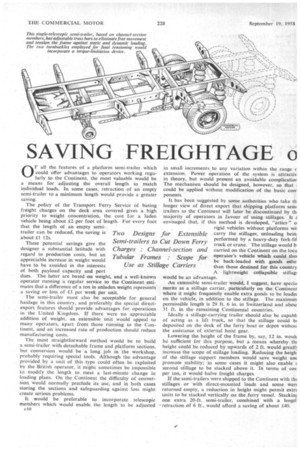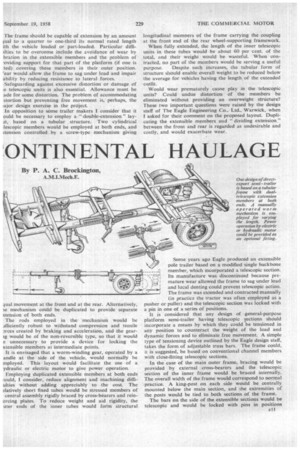SAVING FREIGHTAGE o
Page 96

Page 97

If you've noticed an error in this article please click here to report it so we can fix it.
0 F all the features of a platform semi-trailer which could offer advantages to operators working regularly to the Continent, the most valuable would be a means for adjusting the overall length to match individual loads. In some cases, retraction of an empty semi-trailer to a minimum length would provide a greater saving.
The policy of the Transport Ferry Service of basing freight charges on the deck area covered gives a high priority to weight concentration, the cost for a laden vehicle being about £2 per foot of length. For every foot that the length of an empty semi.
trailer can be reduced, the saving is' about £1 12s.
These potential savings give the designer a substantial latitude with regard to production costs, but an appreciable increase in weight would have to be avoided in the interests of both payload capacity and port dues. The latter are based on weight, and a well-known operator running a regular service to the Continent estimates that a difference of a ton in unladen weight represents a saving or loss of £3 per week per unit.
The semi-trailer must also be acceptable for general haulage in this country, and preferably the special directexport features should provide advantages for operations in the United Kingdom. If there were no appreciable addition of weight, an extensible unit would appeal to many operators, apart from those running to the Continent, and an increased rate of production should reduce manufacturing costs.
The most straightforward method would be to build a semi-trailer with detachable frame and platform sections, but conversion would be a long job in the Workshop, probably requiring special tools. .Although the advantage provided by a unit of this type could often be exploited by the British operator, it might sometimes be impossible to modify the length to meet a last-minute change in loading plans. On the Continent the difficulty of conversion would normally preclude its use, and in both cases storing the sections and safeguarding against loss might create serious problems.
It would be preferable to incorporate telescopic members which would enable the length to be adjusted E 1 0
in small increments to any variation within the range c extension. Power operation of the system is attractiv in theory, but would present an avoidable complicatior The mechanism should be designed, however, so that could be applied without modification of the basic con. portents.
It has been suggested by some authorities who take th longer view of direct export that shipping platform semi trailers to the Continent will later be discontinued by th majority of operators in favour of using stillages. It i envisaged that, if this method is developed, "artics " o rigid vehicles without platforms wil carry the stillages, unloading beini performed by a heavy-duty fork-lit truck or crane. The stillage would carried on the Continent on the loca operator's vehicle which could thei be back-loaded with goods othe than those destined for this country A lightweight collapsible stillagi would be an advantage.
An extensible semi-trailer would, I suggest, have specia merits as a stillage carrier, particularly on the Continent where it might frequently enable extra goods to be loadec on the vehicle, in addition to the stillage. The maximun permissible length is 29 ft. 6 in. in Switzerland and abou 31 ft. in the remaining Continental countries.
Ideally a stillage-carrying trailer should also be capabli of acting as a lift truck, so that the stillage could hi deposited on the deck of the ferry boat or depot withou the assistance of external hoist gear.
Lowering the height of the frame by, say, 12 in. woulc be sufficient for this purpose, but A means whereby thi height could be reduced by upwards of 2 ft. would greatl■ increase the scope of stillage loading. Reducing the heigh of the stillage support members would save weight anc promote stability; in some cases it might also enable second stillage to be stacked above it. In terms of cos per ton, it would halve freight charges.
If the semi-trailers were shipped to the Continent with tht stillages or with direct-mounted loads and some wert returned empty, a reduction in height might permit exM units to be stacked vertically on the ferry vessel. Stackinl one extra 20-ft semi-trailer, combined with a lengtf -retraction of 6 ft.. would afford a saving of about £40. The frame should be capable of extension by an amount p.ial to a quarter to one-third its normal rated length ith the vehicle loaded or part-loaded. Particular diffiilties to be overcome include the avoidance of wear by bration in the extensible members and the problem of -oviding support for that part of the platform (if one is ted) covering these members in their outer position. rear would allow the frame to sag under load and impair ability by reducing resistance to lateral forces.
.Safeguarding against excessive distortion or damage of Ee telescopic units is also essential. Allowance must be ade for some distortion. The problem of accommodating stortion but preventing free movement is, perhaps, the iajor design exercise in the project.
In opposition to some trailer makers I consider that it ould be necessary to employ a " double-extension " lay it,based on a tubular structure. Two cylindrical :lescopic members would be employed at both ends, and ttension controlled by a screw-type mechanism giving longitudinal memoers of the frame carrying the coupling at the front end of the rear wheel-supporting framework.
When fully extended, the length of the inner telescopic units in these tubes would be about 60 per cent. of the total, and their weight would be wasteful. When contracted, no part of the members would be serving a useful purpose. Despite such increases, the tubular form of structure should enable, overall weight to be reduced below the average for vehicles having the length, of the extended outfit.
Would wear prematurely cause play in the telescopic units? Could undue distortion of . the members be eliminated without providing an overweight structure? These two important questions were raised by the design staff of The Eagle Engineering Co.. Ltd., Warwick, when I asked for their comment on the proposed layout. Duplicating the extensible members and "dividing extension," between the front and rear is regarded as undesirable and costly, and would exacerbate wear,
















































































































































































































